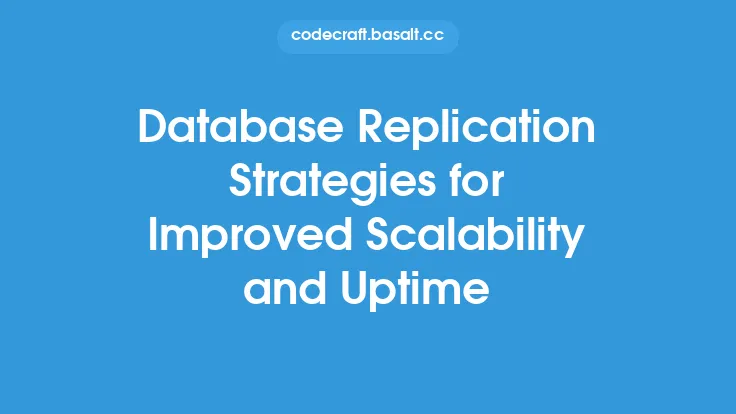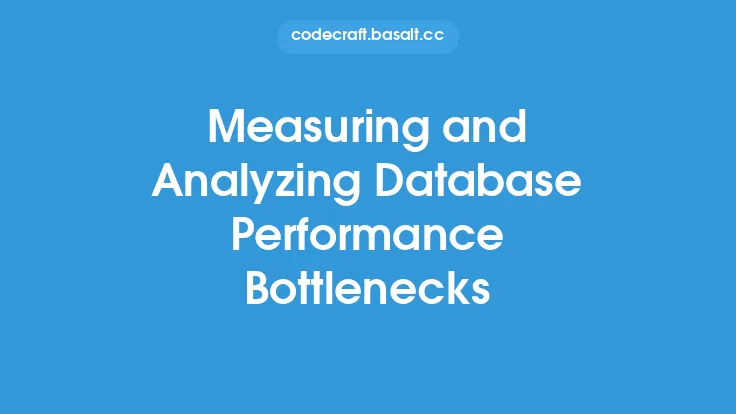Database performance is a critical aspect of any database system, as it directly impacts the overall user experience and the efficiency of the application. One of the key components of ensuring optimal database performance is monitoring and alerting. In this article, we will delve into the strategies and techniques for effective database performance monitoring and alerting, providing you with the knowledge and tools to optimize your database's performance.
Introduction to Database Performance Monitoring
Database performance monitoring involves tracking and analyzing various metrics and indicators to identify potential issues and bottlenecks. This process helps database administrators (DBAs) and developers to quickly detect and resolve problems, ensuring that the database runs smoothly and efficiently. Effective monitoring requires a combination of automated tools and manual analysis, as well as a deep understanding of the database's architecture, configuration, and workload.
Types of Database Performance Metrics
There are several types of database performance metrics that need to be monitored, including:
- Query performance metrics, such as query execution time, query latency, and query throughput
- System resource metrics, such as CPU usage, memory usage, and disk usage
- Storage metrics, such as disk space usage, storage latency, and storage throughput
- Network metrics, such as network latency, network throughput, and network packet loss
- Error metrics, such as error rates, error types, and error messages
Database Performance Monitoring Tools
There are many database performance monitoring tools available, both open-source and commercial. Some popular tools include:
- Nagios, a comprehensive monitoring tool that provides real-time monitoring and alerting capabilities
- Prometheus, a popular open-source monitoring tool that provides a time-series database and alerting capabilities
- Grafana, a visualization tool that provides a user-friendly interface for creating dashboards and charts
- New Relic, a commercial monitoring tool that provides detailed performance metrics and alerting capabilities
- Datadog, a cloud-based monitoring tool that provides real-time monitoring and alerting capabilities
Alerting Strategies
Alerting is a critical component of database performance monitoring, as it enables DBAs and developers to quickly respond to issues and minimize downtime. Effective alerting strategies involve:
- Defining clear alerting thresholds and rules
- Configuring alerting notifications, such as email, SMS, or pager notifications
- Implementing escalation procedures, such as escalating alerts to senior DBAs or managers
- Providing detailed alerting information, such as error messages, query plans, and system metrics
- Integrating alerting with other tools and systems, such as incident management tools and communication platforms
Best Practices for Database Performance Monitoring and Alerting
To ensure effective database performance monitoring and alerting, follow these best practices:
- Monitor database performance regularly, using a combination of automated tools and manual analysis
- Define clear alerting thresholds and rules, based on historical data and performance baselines
- Configure alerting notifications and escalation procedures, to ensure that issues are quickly responded to
- Provide detailed alerting information, to enable quick diagnosis and resolution of issues
- Continuously review and refine monitoring and alerting strategies, to ensure that they remain effective and relevant
Advanced Database Performance Monitoring Techniques
In addition to basic monitoring and alerting, there are several advanced techniques that can be used to optimize database performance, including:
- Predictive analytics, which involves using machine learning and statistical models to predict future performance issues
- Anomaly detection, which involves using algorithms and statistical models to detect unusual patterns and anomalies in database performance
- Root cause analysis, which involves using advanced tools and techniques to identify the underlying causes of performance issues
- Capacity planning, which involves using historical data and performance metrics to predict future capacity requirements
Database Performance Monitoring in Cloud and Hybrid Environments
Database performance monitoring in cloud and hybrid environments requires special consideration, as these environments often involve multiple databases, systems, and providers. To ensure effective monitoring in these environments, follow these best practices:
- Use cloud-native monitoring tools, such as Amazon CloudWatch or Google Cloud Monitoring
- Configure monitoring to account for cloud-specific metrics, such as instance types, regions, and availability zones
- Use hybrid monitoring tools, such as Datadog or New Relic, to monitor both cloud and on-premises databases
- Define clear alerting thresholds and rules, based on cloud-specific metrics and performance baselines
Conclusion
Database performance monitoring and alerting are critical components of any database system, as they enable DBAs and developers to quickly detect and resolve issues, ensuring optimal performance and user experience. By following the strategies and techniques outlined in this article, you can optimize your database's performance, reduce downtime, and improve overall efficiency. Remember to continuously review and refine your monitoring and alerting strategies, to ensure that they remain effective and relevant in an ever-changing database landscape.





